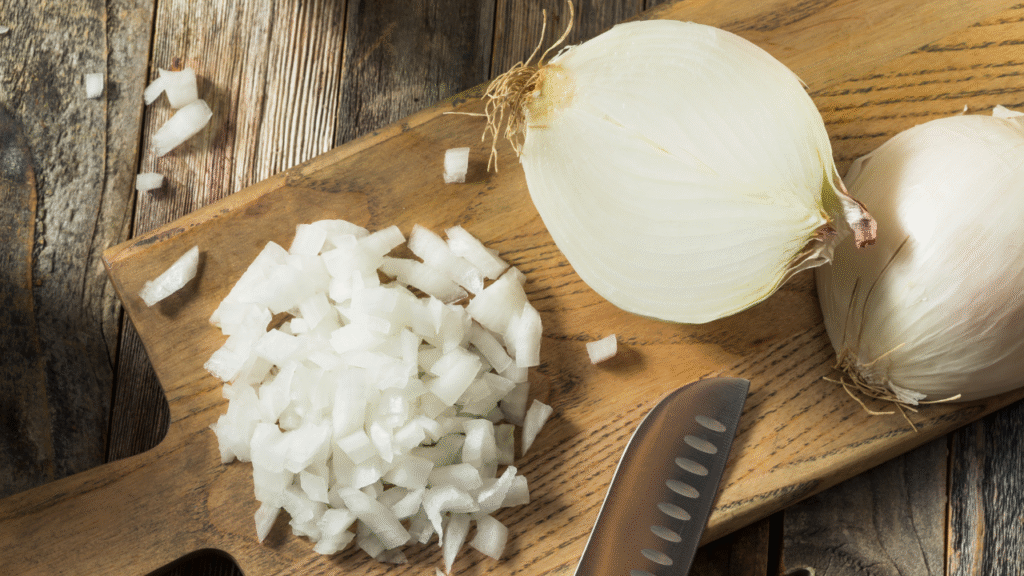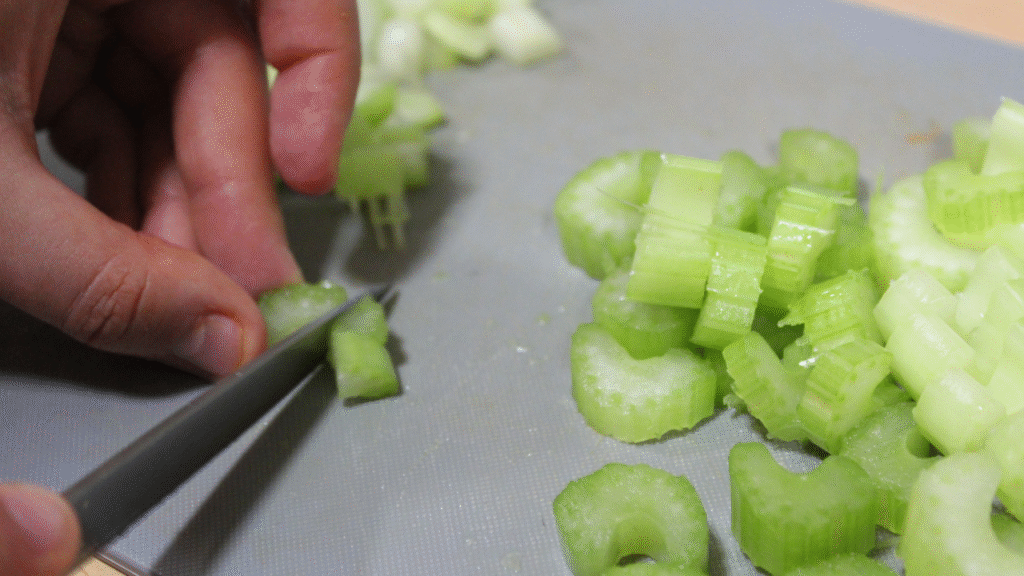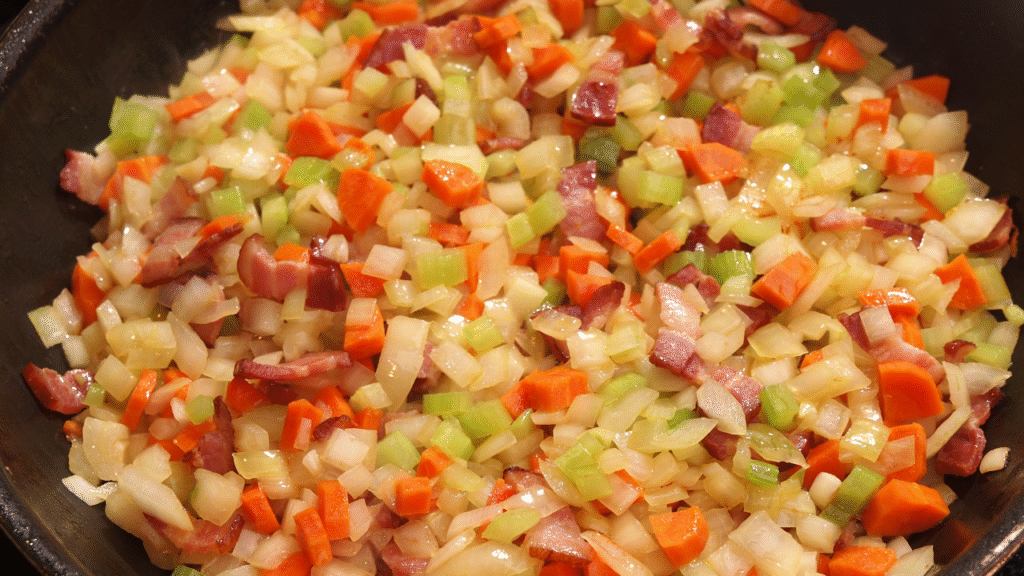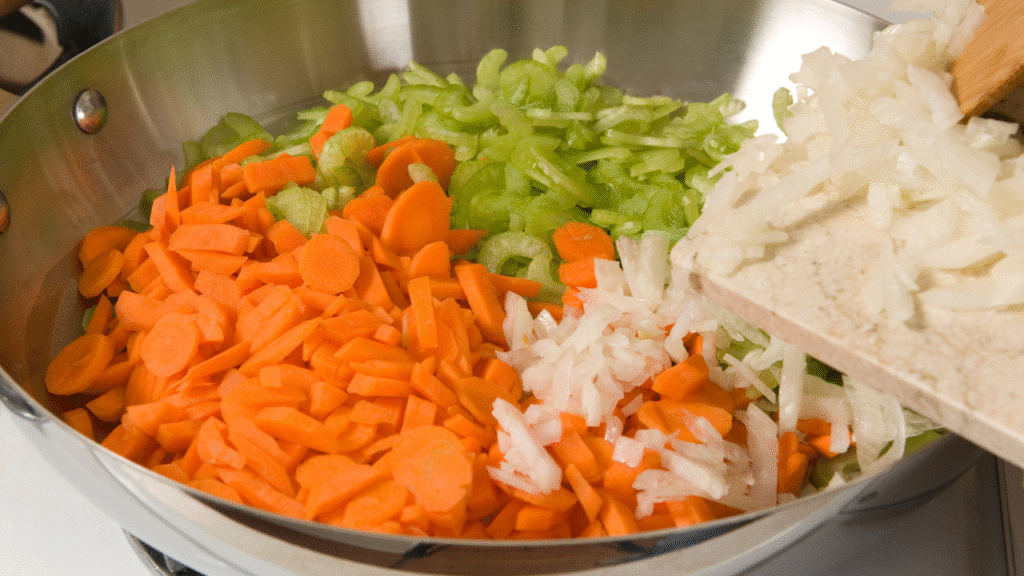Welcome to our ultimate guide on how to Small Dice Onions, Carrots, and Celery—a foundational kitchen skill every home cook should master to enhance flavor, texture, and presentation in their culinary creations.
Whether you’re making a mirepoix for soups and stews or want to improve your knife skills, this guide will walk you through each step to achieve perfectly uniform small dice cuts.
❤️ Why You Will Love This Technique
Small dicing may seem like a minor detail, but it has a major impact on the way your dishes cook, look, and taste. Mastering this knife skill can instantly level up your everyday meals, making prep more efficient and results more consistent. It’s one of those techniques that brings both form and function to the kitchen.
Here’s why it’s worth learning:
- 🔪 Even Cooking: Uniform pieces ensure all your vegetables cook at the same rate, preventing raw centers or mushy edges.
- 🍲 Balanced Flavor: Small cuts help ingredients blend harmoniously, delivering a more cohesive taste in soups, stews, and sautés.
- 👁️ Professional Presentation: Neatly diced veggies add a refined, restaurant-quality look to your dishes.
- ⏱️ Faster, Smarter Prep: Once you get comfortable, small dicing becomes a fast, efficient part of your cooking routine.
- 💪 Kitchen Confidence: This technique sharpens your overall knife skills and gives you more control at the cutting board.
📏 Understanding the Small Dice Cut

When it comes to knife skills, precision matters—and the small dice is one of the most versatile cuts you can master. It’s all about transforming your vegetables into uniform ¼-inch cubes that cook evenly and look sharp on the plate. This size strikes a balance between texture, flavor distribution, and presentation, making it ideal for everything from hearty soups to delicate garnishes.
Here’s how small dice compares to other common cube cuts:
| Dice Type | Cube Size (Approx.) | Best Used For | Visual Impact |
|---|---|---|---|
| Small Dice | ¼ inch (0.6 cm) | Soups, stews, sauces, stuffing, mirepoix | Neat, professional, consistent |
| Medium Dice | ½ inch (1.3 cm) | Roasted veggies, salsas, chunky salads | Balanced texture & visual appeal |
| Large Dice | ¾ inch (2 cm) | Gratin, roasted root vegetables, stews | Rustic and bold presentation |
🧰 Essential Kitchen Tools
To achieve the perfect small dice, you’ll need a few essential kitchen tools:
- Sharp Chef’s Knife: A high-quality, sharp chef’s knife is crucial for clean cuts and safety.
- Sturdy Cutting Board: A stable cutting board prevents slipping and ensures precise cuts.
- Vegetable Peeler: A good peeler quickly removes skins from carrots and other vegetables.
- Kitchen Towel: To keep the cutting board stable and maintain a clean work area.
🧅 Step-By-Step Guide to Small Dicing Onions

Let’s start with onions. Follow these steps to master the small dice and elevate your culinary repertoire with a professional touch.
Step 1: Peel and Halve the Onion
- Begin by cutting off the top and root ends of the onion.
- Make a shallow cut through the skin from top to bottom and peel off the outer layer.
Step 2: Make Horizontal Cuts
- Place the onion half flat side down on the cutting board.
- Hold the onion with your fingers tucked in (in a claw grip) and make horizontal cuts parallel to the cutting board, spaced about 1/4 inch apart.
- Be careful not to cut through to the root end, as this will cause the layers to separate.
Step 3: Make Vertical Cuts
- Next, make vertical cuts perpendicular to the horizontal cuts, spacing them about 1/4 inch apart.
- These cuts should also stop just short of the root end.
Step 4: Dice the Onion
- Finally, slice down vertically across the onion, cutting through the layers to create small, even dice.
- Discard the root end when you’re done.
🥕 Step-By-Step Guide to Small Dicing Carrots

Next, we’ll tackle carrots—learn how to achieve consistent small dice with this vibrant and nutritious vegetable.
Step 1: Peel the Carrots
- Start by peeling the carrots to remove the outer skin.
- Trim off the top and bottom ends.
Step 2: Cut into Uniform Lengths
- Cut the carrots into lengths of 2-3 inches to make them easier to handle.
Step 3: Square Off the Carrot
- Square off the rounded sides of the carrot to create a rectangular shape. This will help in making uniform cuts.
Step 4: Cut into Planks
- Cut the carrot into thin planks, approximately 1/4 inch thick.
Step 5: Cut into Strips
- Stack the planks and cut them into 1/4-inch wide strips.
Step 6: Dice the Carrot
- Finally, cut the strips into small, even dice by making cuts perpendicular to the strips.
🥬 Step-By-Step Guide to Small Dicing Celery

Finally, we’ll focus on celery. Discover the techniques for dicing this crunchy vegetable into perfect small cubes.
Step 1: Trim the Celery
- Start by trimming the ends of the celery stalks and removing any leaves.
Step 2: Cut into Uniform Lengths
- Cut the celery stalks into lengths of 2-3 inches.
Step 3: Cut into Planks
- Cut the celery into thin planks, approximately 1/4 inch thick.
Step 4: Cut into Strips
- Stack the planks and cut them into 1/4-inch wide strips.
Step 5: Dice the Celery
- Finally, cut the strips into small, even dice by making cuts perpendicular to the strips.
💡 Tips and Tricks for Perfect Small Dicing
To make your small dicing process smoother and more efficient, here are some expert tips and tricks to keep in mind:
- Sharp Knife: Always use a sharp knife for cleaner cuts and better control.
- Stable Cutting Board: Ensure your cutting board is stable to prevent accidents. You can place a damp towel underneath to keep it from slipping.
- Claw Grip: Use the claw grip to hold the vegetables, keeping your fingers safe and providing better control.
- Consistent Sizes: Ensure consistency in your cuts to achieve even cooking and a professional appearance.
- Practice: Like any skill, practice makes perfect. Take your time and focus on improving your technique.
❌ Common Mistakes to Avoid
Avoid these common mistakes to ensure your small dice cuts are always precise and professional-looking:
- Dull Knife: A dull knife can cause uneven cuts and increase the risk of accidents.
- Inconsistent Sizes: Inconsistent cuts can lead to uneven cooking and affect the overall texture of your dish.
- Rushing: Take your time to make precise cuts. Rushing can lead to mistakes and uneven pieces.
- Improper Grip: Holding the knife or vegetables improperly can make cutting difficult and unsafe.
🍲 Uses for Small Diced Onions, Carrots, and Celery

Small diced onions, carrots, and celery are the building blocks of countless recipes – learn how to use them to enhance soups, stews, salads, and more:
- Mirepoix: This classic French base for soups and stews consists of small-diced onions, carrots, and celery.
- Salads: Add small diced vegetables to salads for a burst of color and flavor.
- Stuffing: Use small-diced vegetables in the stuffing for an even distribution of ingredients.
- Sautéing: Small dice cuts cook quickly and evenly, making them perfect for sautéing in various dishes.
🧊 Storing and Prepping Ahead

Save time in the kitchen by learning the best methods for storing and prepping your small-diced vegetables ahead of time:
- Refrigeration: Store small diced vegetables in airtight containers in the refrigerator for up to 3-5 days.
- Freezing: For longer storage, briefly blanch the vegetables, cool them, and then freeze them in a single layer before transferring them to freezer bags.
- Prepping Ahead: Dice your vegetables ahead of time and store them in the refrigerator to have them ready for quick meals throughout the week.
🏁 Final Slice

By mastering the small dice cut for onions, carrots, and celery, you’re adding a powerful skill to your kitchen toolkit. It’s a simple technique that brings out better flavor, faster cooking, and a polished presentation—all from just a few thoughtful cuts. Whether you’re prepping a weeknight stew or building a classic mirepoix, small dice is the foundation that sets your dish apart.
Ready to level up your knife game? Grab your chef’s knife, practice those cuts, and tag your creations with #KitchenKnowHow—we’d love to see your precision in action.
Happy dicing!
🎧 Prefer to listen to this guide?
Here’s the audio version—perfect for reviewing tips while cooking or commuting.
❓ FAQs – Frequently Asked Questions

What is the difference between a small dice and a medium dice?
A small dice cut is typically 1/4-inch cubes, while a medium dice cut is 1/2-inch cubes. The size difference can affect the cooking time and texture of your dish.
Why is it important to have uniform cuts?
Uniform cuts ensure that all pieces cook evenly, preventing some parts from being undercooked while others are overdone. It also improves the presentation of your dish.
How do I keep my fingers safe while dicing?
Use the claw grip, where you tuck your fingers under, and use your knuckles as a guide for the knife. This grip keeps your fingertips safe from the blade.
Can I use a food processor for small dicing?
While a food processor can save time, it may not achieve the same uniformity and precision as hand-cutting. For the best results, use a sharp knife and practice your technique.
What type of knife is best for small dicing?
A sharp chef’s knife is ideal for small dicing due to its versatility and precision. Make sure it’s well-maintained and properly sharpened.
How can I prevent my eyes from tearing up when cutting onions?
Chilling the onion in the refrigerator before cutting, using a sharp knife, and cutting near an open flame can help reduce tearing. You can also try wearing goggles to protect your eyes.
How do I sharpen my knife at home?
You can use a sharpening stone, an honing rod, or a knife sharpener. Regularly honing your knife helps maintain its edge, while sharpening should be done as needed to restore the blade’s sharpness.







